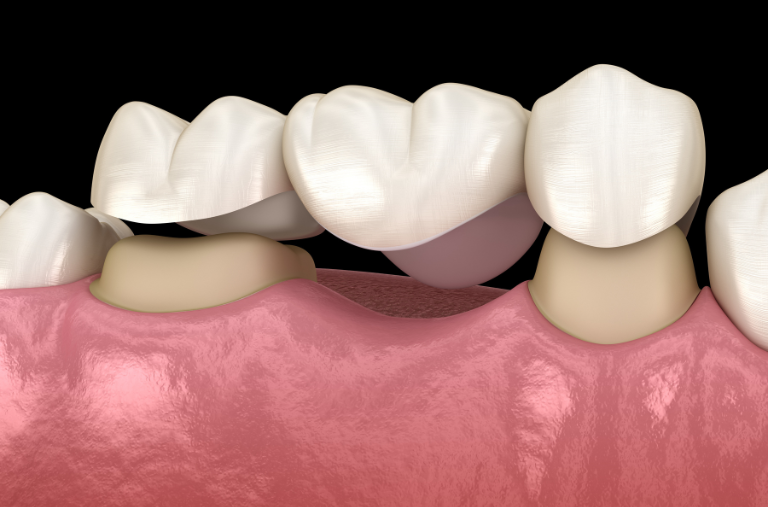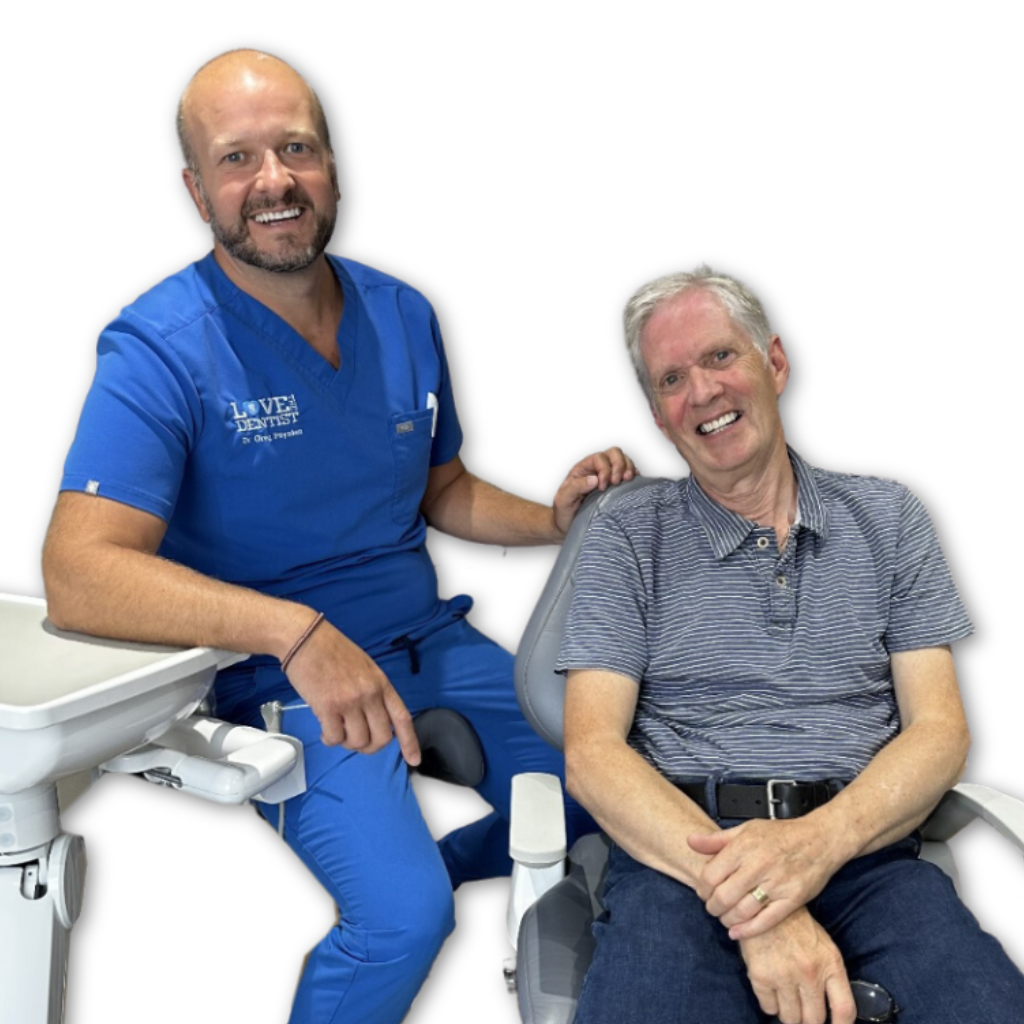dental bridges
A dental bridge is a very intelligent way of replacing missing teeth by using existing teeth on either side of the gap. There are several versions of a bridge:
- Maryland Bridge – A prosthetic tooth with a ‘wing’ attached. The ‘wing’ is cemented onto the back of the natural tooth next to the gap, allowing the prosthetic tooth to fit in the gap. This method usually requires little preparation for the natural tooth and is normally used for the front teeth.
- Traditional Bridge – A prosthetic tooth is sandwiched between and attached to two crowns, which are placed on top of the natural teeth on either side of the gap. The two natural teeth require some preparation and have often already had dental work in the past. The prosthetic tooth sits in the gap, being secured by the teeth on either side.
- Cantilever Bridge – One or more prosthetic teeth are attached to a crown. The crown is placed on top of the natural tooth at the side of the gap, supporting the prosthetic teeth. This method is usually used if there is no other tooth on the other side of the gap or there is a dental reason for not wanting to use another natural tooth.

WHAT HAPPENS DURING A BRIDGE PREPARATION AND FIT APPOINTMENT?
After an initial assessment and treatment plan, the tooth, or teeth, are prepared for the bridge. This involves shaping the tooth to fit the bridge without affecting your natural bite. Local anaesthesia is administered to numb the area around the teeth involved in the bridge preparation. This ensures that you remain comfortable throughout the procedure. The amount of tooth reduction required will depend on the specific case and the type of bridge being used. Once the teeth are prepared, a scan is taken of the teeth and the surrounding gum tissue.
This produces a 3D image of the area which is then sent to the dental laboratory who create a custom bridge that fits precisely in your mouth. While the permanent bridge is being fabricated at the dental laboratory, a temporary bridge is usually placed to protect the exposed teeth and gums. This temporary bridge is typically made from acrylic and provides aesthetic and functional benefits until the final bridge is ready. The shade of the permanent bridge will be determined by matching it to the colour of your natural teeth for a more seamless blend.
In a subsequent appointment, the final bridge will be cemented or bonded onto the prepared teeth, restoring your smile, improving your bite, and filling the gap caused by missing teeth.
dental bridge aftercare
After getting a dental bridge, it’s important to follow proper aftercare instructions to ensure the longevity and health of your bridge. Here are some essential guidelines to keep in mind:
- Avoid Causing Trauma: If you have had a local anaesthetic, it may take up to 4-6 hours for the effects to wear off. During this time, please ensure that you refrain from chewing your lip, inner cheek, tongue or soft tissues and drinking hot drinks to avoid unwittingly causing trauma to the area.
- Tenderness: Your mouth has been worked on, so there may naturally be a small amount of tenderness, bruising, and sensitivity in the area for a couple of days. If there are still worsening symptoms of pain after 7 days, contact the practice for advice.
- Oral Hygiene: Maintain excellent oral hygiene practices by brushing your teeth at least twice a day with a soft-bristle toothbrush and fluoride toothpaste. Floss between the teeth and around the bridge using dental floss, interdental brushes, or a water flosser to remove plaque and food particles.
- Bridge Cleaning: Clean your dental bridge thoroughly to prevent the buildup of bacteria and plaque. Use a bridge threader or floss threader to pass dental floss beneath the bridge and remove any debris. You may also consider using a bridge-specific brush or an antimicrobial mouth rinse.
- Regular Dental Visits: Schedule and attend regular dental check-ups and cleanings, typically every six months. These visits allow your dentist to examine the bridge, assess its condition, and professionally clean the area to maintain optimal oral health.
- Be Mindful of Eating Habits: Avoid chewing on hard or sticky foods that can potentially damage the bridge or dislodge it. It's advisable to cut large or hard foods into smaller, more manageable pieces. Additionally, try to minimise or eliminate habits such as biting nails, chewing on pens, or using your teeth as tools to prevent accidental damage to the bridge.
- Avoid Teeth-Straining Habits: Refrain from habits such as grinding or clenching your teeth, as they can put excessive force on the bridge and weaken its foundation. If you have bruxism (teeth grinding), we can recommend wearing a nightguard to protect your teeth and bridge while you sleep.
- Watch for Signs of Concern: Pay attention to any changes or issues related to your dental bridge. Contact us if you notice loose or shifting of the bridge, pain or sensitivity around the bridge area, or any signs of infection like swelling or persistent bad breath.
-
Overall Oral Health: Take care of your overall oral health by following a balanced diet, limiting sugary and acidic foods and beverages, and refraining from smoking or using tobacco products. These factors can affect the longevity and integrity of your dental bridge, as well as your overall oral health.
Remember, it's essential to communicate with us about any concerns or questions you may have regarding your dental bridge. By practising good oral hygiene and following these aftercare guidelines, you can help ensure that your dental bridge remains functional and lasts for years to come.
dental bridge frequently asked questions
Dental bridges work by filling the gap created by a missing tooth. The bridge is anchored to the adjacent teeth or dental implants, which act as supporting teeth. This helps to restore both the function and appearance of your teeth.
Dental bridges offer several benefits, including restoring your smile, maintaining the shape of your face, preventing remaining teeth from drifting out of position and improving your ability to chew and speak properly.
Most people with one or more missing teeth are suitable candidates for dental bridges. However, it’s essential to have healthy adjacent teeth to support the bridge. Your dentist will evaluate your oral health to determine the best treatment option for you.
Caring for a dental bridge is similar to caring for your natural teeth. Brush and floss daily, focusing on the area around the bridge and the supporting teeth. Regular dental check-ups are also crucial to ensure the longevity of your dental bridge and overall oral health.
Regular dental visits and maintaining healthy supporting teeth are key factors in the lifespan of your dental bridge. With proper care and good oral hygiene, dental bridges can last many years, often between 5 to 15 years or longer. The longevity of your dental bridge depends on several factors, including the type of bridge used and how well you maintain it. For instance, an adhesive bridge, which uses dental cement to bond the artificial tooth to the adjacent teeth, requires meticulous care to ensure its durability.
Dental bridges can be made from various materials, including porcelain, ceramic, gold, alloys, or a combination of these materials. Porcelain and ceramic bridges are popular for their natural appearance, closely matching the colour of your existing teeth.
Yes, a dental bridge can improve your oral health by preventing the remaining teeth from shifting out of position, reducing the risk of gum disease, and maintaining proper bite alignment. This contributes to better overall dental and oral health.
The procedure for getting a dental bridge is generally not painful. Your dentist will use local anaesthesia to numb the area during tooth preparation and fitting. You may experience some mild discomfort afterwards, but this can be managed with over-the-counter pain relievers.
Dental bridges are a popular choice for replacing missing teeth due to their durability and natural appearance. Compared to dentures, bridges are fixed and offer more stability. Compared to implants, bridges can be less invasive and more affordable, although they may require more maintenance in the long term.
Remember, it's essential to communicate with us about any concerns or questions you may have regarding your dental bridge. By practicing good oral hygiene and following these aftercare guidelines, you can help ensure that your dental bridge remains functional and lasts for years to come.


